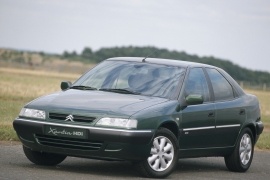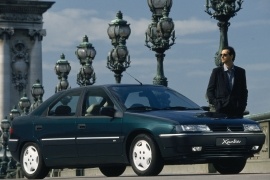CITROEN Xantia Models/Series Timeline, Specifications & Photos
First production year: 1993
Engines: Gasoline, Diesel
Body style: Hatchback
Citroen introduced a facelift for the Xantia range in 1998, improving the car's look and the engine lineup.
The Xantia was remembered for the Activa version, which managed to provide a 1.2 g on the skidpad, which was the best in the world at that time. It was still better than most supercars from its era. Worth mentioning that the C5 Corvette from the same era managed a 1.0 g on the slalom test. Citroen achieved that astonishing performance thanks to its advanced active suspension system, which hardened the suspension for the outer wheels.
For the 1998 model, the French carmaker shaved most of the car's edges. Since it didn't go with the flow of the bio-design trend, it kept its identity. The narrow and angular-shaped headlights received a rounded upper corner towards the car's center. Citroen changed the hood and included the grille on its front side, while on the non-facelifted version, it sported it on an independent body panel. A reshaped front bumper featured an additional cooling area on the lower side, flanked by the fog lights.
Inside, the carmaker improved the materials on the interior. Its dashboard featured the same dashboard with the instrument cluster extended over the center stack. Citroen placed the unessential gauges for the fuel and temperature on the sides of the instrument panel, leaving the speedometer and tachometer in the driver's main visibility area.
Under the hood, the carmaker dropped the 1.6-liter gasoline engine and left the improved, 1.8-liter four-banger as the base version. It also improved the V-6 powerplant and raised its power by two horses. Not much, but with lower emission levels.
Citroen introduced the Xantia in 1993 as a replacement for the successful but aging BX lineup. The result was impressive by all standards, especially in the handling department.
With the wedged shapes of the '80s gone and the rising bio-design trend on the market, Citroen managed to create a vehicle that aged well and was a pleasant surprise for its customers. In addition, it was a shocking discovery for its competitors since it established a world record for handling, outpacing all supercars in the world at the elk-avoiding test. It was a benchmark even decades after it was introduced in December 1992.
After the successful BX, Citroen chose to work with Bertone studios again to create a stylish vehicle. Thus, the Xantia featured a slim front end with narrow headlights and a three-slat grille supporting the "double-chevron" chromed badge. In addition, the raked windshield, short roof, and sloped rear end created an image of a sporty yet spacious vehicle.
Inside, Citroen didn't want to go for a conservative design, and, unlike most carmakers, it didn't feature a raised instrument cluster. That was in line with the rest of the dashboard and extended over the center stack. Also, Citroen arranged the unessential gauges for the fuel and temperature on the sides of the instrument panel, leaving the speedometer and tachometer in the driver's main visibility area. Due to its sloped rear end, it looked like there was no headroom on the car's back seats, and yet, it was adequate for average-sized adults.
Citroen offered the Xantia with a wide choice of gasoline and turbo-diesel engines. But the most impressive part of the vehicle was the Hydroactive suspension that could keep the car flat as a brick even during high-speed cornering.

